One of the best and most effective methods of applying paint on any surface is to spray it on the surface using a paint sprayer.
Spraying it allows it to penetrate more evenly through all the pits and crevices of the surface, thus resulting in a more even and uniform appearance.
However, there’re many types of paint sprayers out there and choosing the right type for the project you have in hand can be quite tricky especially if you haven’t used one before.
The one you choose however usually depends on a few factors such as:
-
- The type of paint you want to use
- Amount of paint needed
- Mess created or overspray
- Material or surface you’re painting
- Speed of application
- The resulting finish
- Ergonomics or comfort
Considering these factors above will help you narrow down your choices and pick a very good sprayer for your project.
With that said, the following is a list of the different types of paint sprayers and how they compare to each other considering the factors I mentioned above.
Table of Contents
Air Paint Sprayers
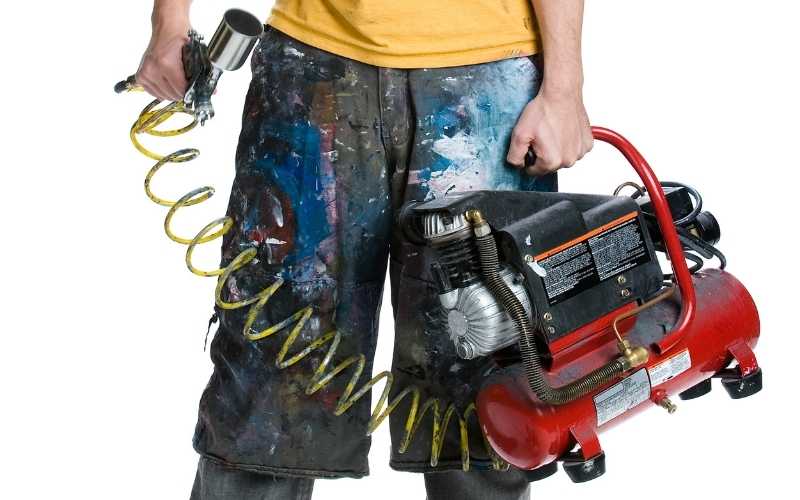
Air paint sprayers make use of compressed air to atomize the fluid. It usually consists of an air gun with a spray tip or nozzle, a cup or basin and the air compressor.
Pressing the trigger of the air gun causes the paint to mix with the compressed air stream and released through the nozzle onto the object to be covered.
The shape and size of the nozzle determines the spray pattern and consistency. It also determines the viscosity of the paint you can spray with it.
So, you can choose to buy different sizes of tips for the same air sprayer so you can apply different types of fluids and paint different types of objects or surfaces.
Air paint sprayers can be used for furniture, decks, fence, doors, cabinets, interior and exteriors of buildings.
HVLP Paint Sprayers
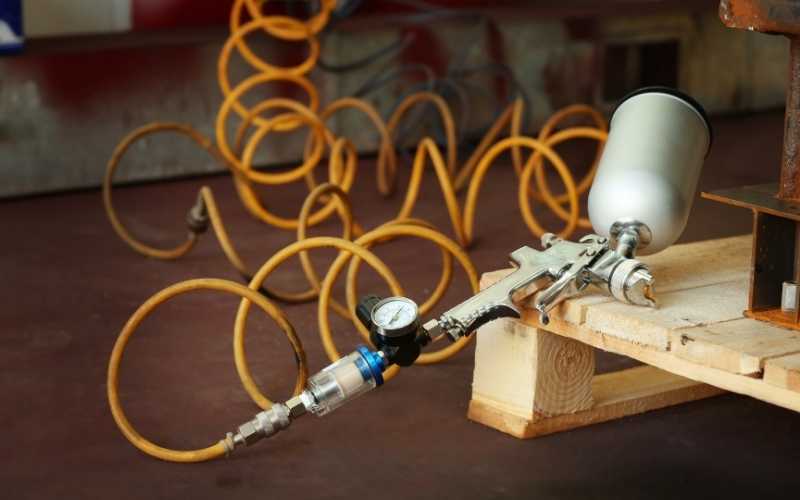
HVLP is an acronym which translates to High Volume Low Pressure. A HVLP spray gun is just like a conventional air paint sprayer but it makes use of a high volume of air at a much lower pressure to atomize the fluid and propel it to the surface or object.
This results in very little overspray compared to a standard air sprayer because the lower pressure causes more of the fluid to reach the surface instead of ending up in the surrounding air and on other surfaces.
There’s less material consumption and air pollution. HVLP units are normally used for automotive parts, marine vessels like ships, furniture finishing, scenic painting, cosmetic and even architectural coating.
With an HVLP spray gun, pressure from the air compressor is usually reduced using a regulator so that the paint atomizes properly.
HVLP sprayers usually consume a high volume of air between 8 to 20 cfm, so you should always go for a suitable air compressor to match the one you have.
Advantages
- Very little overspray compared to air spraying units.
- Less air pollution.
- Reduces the amount of paint needed so it doesn’t ends up in the air and surrounding surfaces.
- Improved finish.
Disadvantages
- Takes more time to paint a surface or an object.
- Reduced user comfort. Most HVLP systems comes with spray guns with refill cups. That means you’re always carrying some paint with you in addition to the weight of the spray gun.
- You have to refill the cup several times as you can spray directly from a bucket.
LVLP Paint Sprayer

LVLP stands for Low Volume Low Pressure. These are paint sprayers that use a low volume of air at low pressures to atomize and discharge the fluid on the surface.
The main purpose is to further reduce the amount of overspray or amount of atomized fluid that ends up in the air instead of the surface being covered.
This also reduces the amount of compressed air consumed as a low volume of air at low pressures is needed to spray the paint.
Airless Paint Sprayer
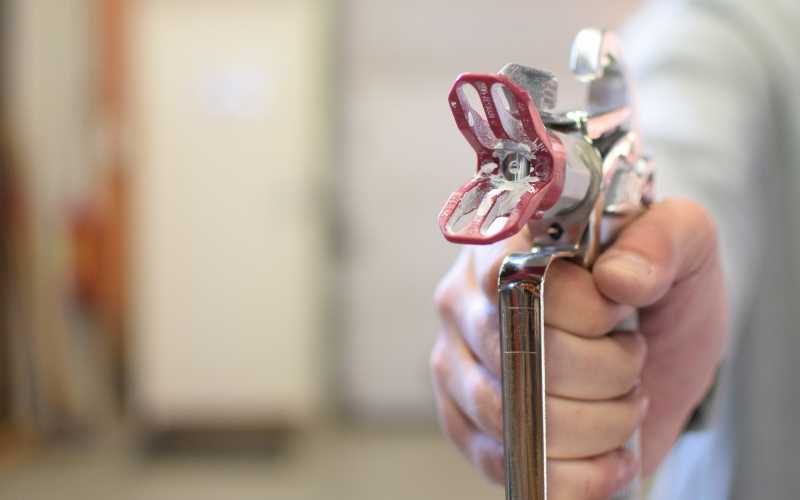
These are one of the most common type of paint sprayers out there. As the name implies, you don’t need compressed air or an air compressor to make it work.
Instead, it makes use of a high pressure pump capable of producing from 500 to 7500 PSI of pressure in combination with an electric motor to atomize the paint and produce different spray patterns with the help of tips or nozzles of different sizes.
Like I mentioned earlier, they’re very common among professionals because they can be used to spray both light and thick fluids and coatings by simply changing the spray tip.
You’ll usually find these with contract painters who use them for painting heavy duty industrial, marine, and chemical coatings. They can be used for both interior and exteriors of residential buildings and a lot more.
Most airless paint sprayers like the Graco series, come equipped with pumps that are powered with electric motors. But there are airless pumps that are also powered with compressed air or hydraulic systems.
They can also be gasoline or diesel-powered. These types come with gas engines and are usually more mobile and can be used in places where there’s no electricity, as long as you have gasoline.
Advantages
- The paint or coating penetrates better into pits and crevices on the surface being painted because of the high pressure pump spraying it through the tip.
- Thick coatings can be sprayed at once reducing the number of coats required to achieve a uniform coat.
- No need for paint refill because airless sprayers usually spray the coating directly from the bucket holding it.
- Airless sprayers are also very comfortable to use compared to other types, because the spray gun does not hold any refill cup or basin, so it weighs significantly less since there’s no other weight to carry apart from the weight of the sprayer.
- Flexibility of use is also an advantage because it can be used to spray different types of coatings, chemicals and stains of different texture and viscosity. You just have to choose the right tip.
Disadvantages
- Produces a lot of air pollution because of overspray due to the high pressures at which the paint escape the tip or nozzle.
- Requires the use of more paint than needed as a considerable amount of the ends up in the air and on the surrounding surfaces.
What to Consider when Choosing an Airless Paint Sprayer

When it comes to choosing an airless paint sprayer, there’re many models and options you can choose from.
It’s a decision you have to consider seriously especially if you haven’t used one before. To help you make the right decision, here’re a few important pointers we think you should consider.
What Do You Want To Spray With It?
Without doubt, this is the first question you should ask yourself if you’re shopping for an airless paint sprayer. What do you want to spray with it?
First, you need to know the material you’re spraying. Knowing the material you’re spraying will help you decide on the type of machine to buy.
Each sprayer machine is designed for a particle purpose. Some are designed to spray texture and paint, some spray texture only, while others spray only paint.
In other words, some sprayers are designed to spray lighter fluids like lacquer, stain and oil base paint, while other sprayers are designed to atomize and spray thicker fluids like heavy latex and acrylics.
So, make sure you check the sprayer specs or data sheet and ensure the machine you’re trying to purchase can spray the fluid you intend to spray with it.
Spray Tip Support
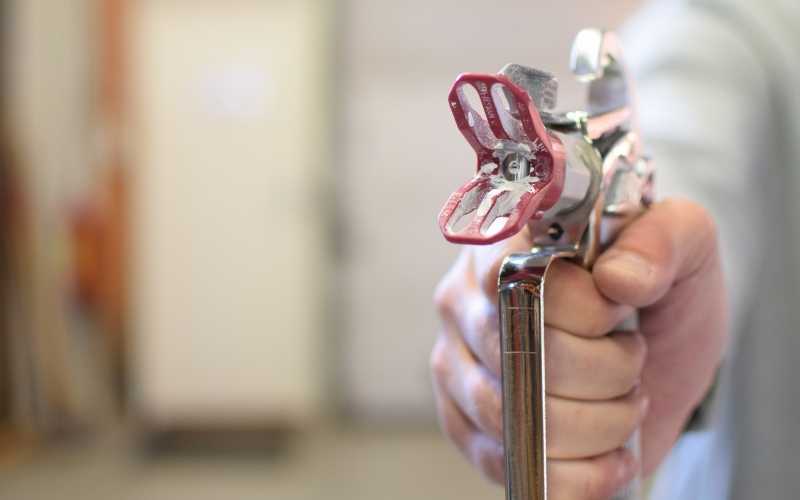
This is further emphasizing the previous point. Choose a machine that can support the spray tip you intend to use.
The spray tip is a very important component of any airless paint sprayer because it determines the type of fluid you can spray with the machine.
So check the tip rating of the sprayer. That will tell you the type of paint or fluid you can spray with it. The following is table showing the recommended tip sizes you can use for different types of paint and fluids.
| Fluid Material | Recommended Spray Tip |
|---|---|
| Lacquer and Stain | .009 to .013 |
| Oil based paint | .013 to .015 |
| Latex | .015 to .019 |
| Heavy Latex and Smoooth Elastomeric | .021 to .025 |
| Elastomeric and Blockfiller | .025 to .035+ |
Frequency of Use
How do you plan to use your airless paint sprayer? Are you a homeowner / diyer who wants to engage in some DIY spray painting projects at home or you’re a contractor that will be using the machine monthly, weekly or even daily?
The frequency of use should surely be a major factor that should influence your choice. For instance, each Graco airless paint sprayer and many other models I’ve seen comes with an annual use recommendation in gallons per year.
For instance, the Graco X7 has an annual user recommendation of 125 gallons per year, while the ProX19 has an annual use recommendation of 500 gallons per year.
With the X7, it’s not recommended that you spray more than 125 gallons of paint with it in a single year. Of course, you can push the machine to the limit and spray more than that, but if you do that, you’re overworking the pump and will definitely reduce the life of the machine.
So, if you’re a contractor who’s looking for a machine you can use several times in a year to undertake several projects, it’s better to go for a sprayer with the capacity to spray more than that volume of paint so it can cope with the frequency at which you use it.
On the other hand, if you’re a homeowner or DIYer with just few projects to handle, you can choose one that spray less volume of paint per year.
Ease of Cleanup
Cleanup is very important with any paint sprayer. You always want to clean off the paint in the sprayer after using it.
Some machines are easier to clean than other. For instance, Graco sprayers come with a powerflush adapter that allows you to connect the machine to a garden hose for easier cleanup.
Titan sprayers also has similar features that allows you to clean up the sprayer easily. So, do your research properly and ensure you don’t have to pick the machine apart in order to clean it.
Electrostatic Sprayers
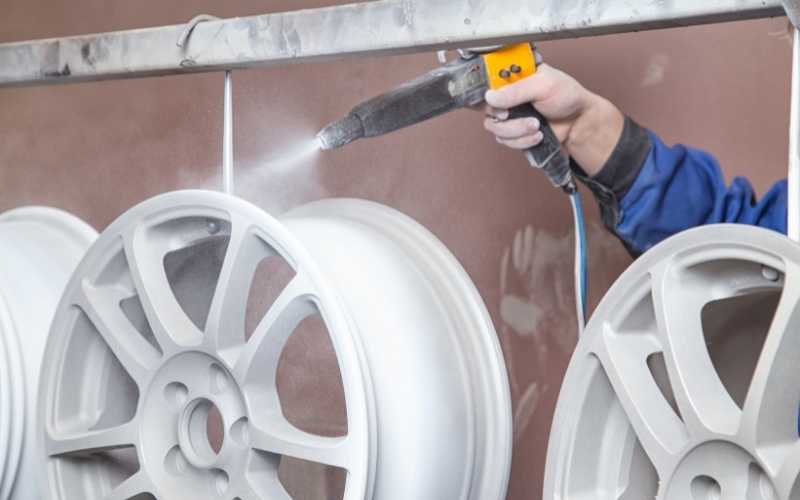
In the late 1940s, Harold Ransburg discovered and patented electrostatic spray painting or powder coating.
He found that the atomized paint particles can be negatively charged, thereby repelling each other as they exit the spray tip, while they attract and stick to the object being covered with paint because it’s positively charged or grounded.
Electrostatic spray painting is built on the principle that like charges repel each other and unlike charges attract.
This method of spraying fluids greatly increase the amount of the fluid that sticks to the object, and thus reduces the amount of fluid material used. Although you should take some precautions when carrying out this type of painting.
Electrostatic spraying also makes it possible for the coating to cover hard to reach areas of the object as the particles are naturally drawn or attracted to every part of it. For instance when painting the front of a cylinder, the coating can be seen to stick to the back of the cylinder even though you’re applying it from the opposite direction.
After the coating is applied, the object is then baked to attach the coating permanently to the object.
Electrostatic sprayers have a lot of applications in automotive, industrial and marine works. It’s used for painting car body panels, bike frames, and even some engine parts.
Advantages
- Very little overspray because most of the paint ends up sticking to the object.
- Provides a better finish as the fluid is more evenly distributed on the object with every area on it touched.
Disadvantage
- High initial cost of buying equipment and setting it up. Although there are now budget friendly electrostatic options you can go for.
- Spray back on the user. This can be eliminated if the user is properly grounded.
Air-Assisted Airless Sprayers
Airless paint sprayers make use of fluid pressure alone by means of a pump to atomize the paint. With air-assisted airless, both fluid pressure and air pressure is used to atomize the paint.
This allows much thicker or viscous coatings to be sprayed than is possible with a standard air sprayer. The fluid pressure is provided with the aid of an airless pump while the air is introduced into it with the aid of an air nozzle or an air cap.
The added compressed air improves the atomization of the coating and improves the overall finish on the surface. It’s also easier to control the spray pattern with an air-assisted airless unit than with a pure airless unit.


Thank you for this article.
I am a serious diyer and have done lots of cabinets and woodwork at home.
I have both air sprayer and hvlp sprayer. I even have a Wagner 570.
My next project is my Kitchen cabinets. Believe it or not, the painting is what scare me the most. At the end, I want to make sure my customer (my wife) is 100% satisfied (no pun intended)
I will got with the Airless sprayer based on this article, which I will have to acquire.
Any recommendations will be greatly appreciated.
Thanks once again for this info